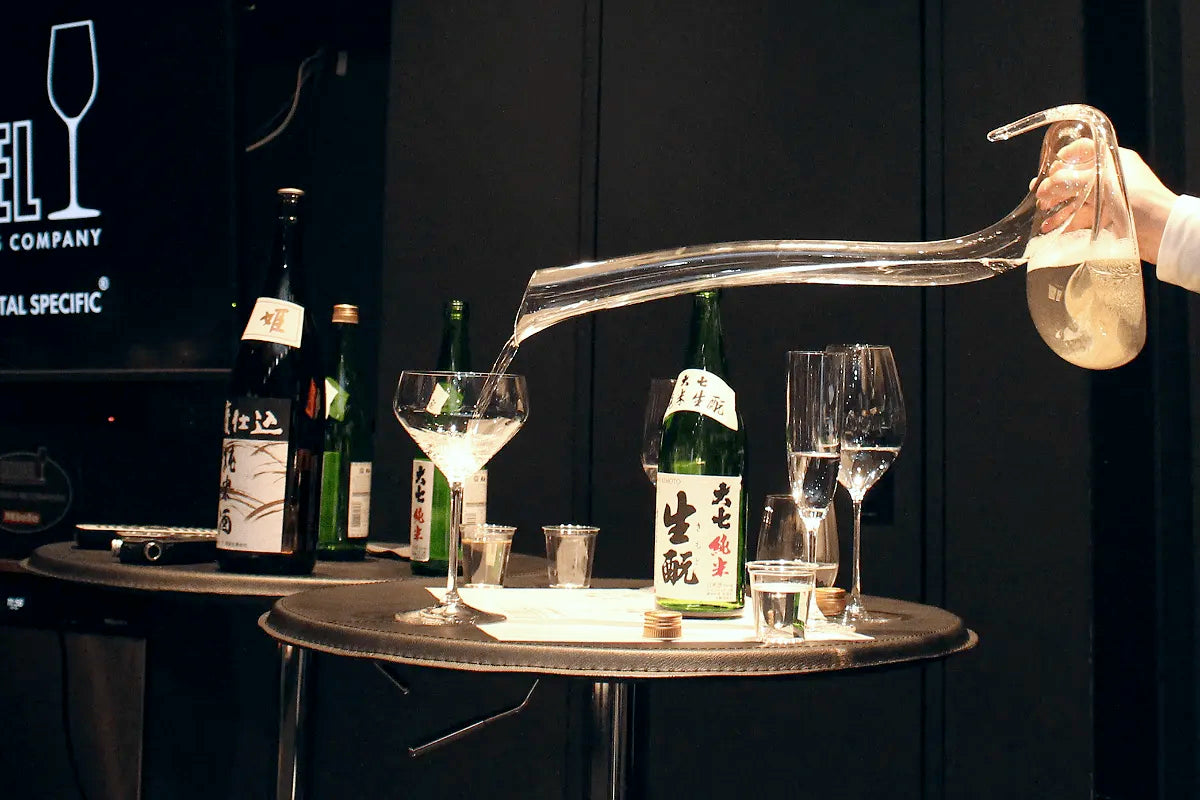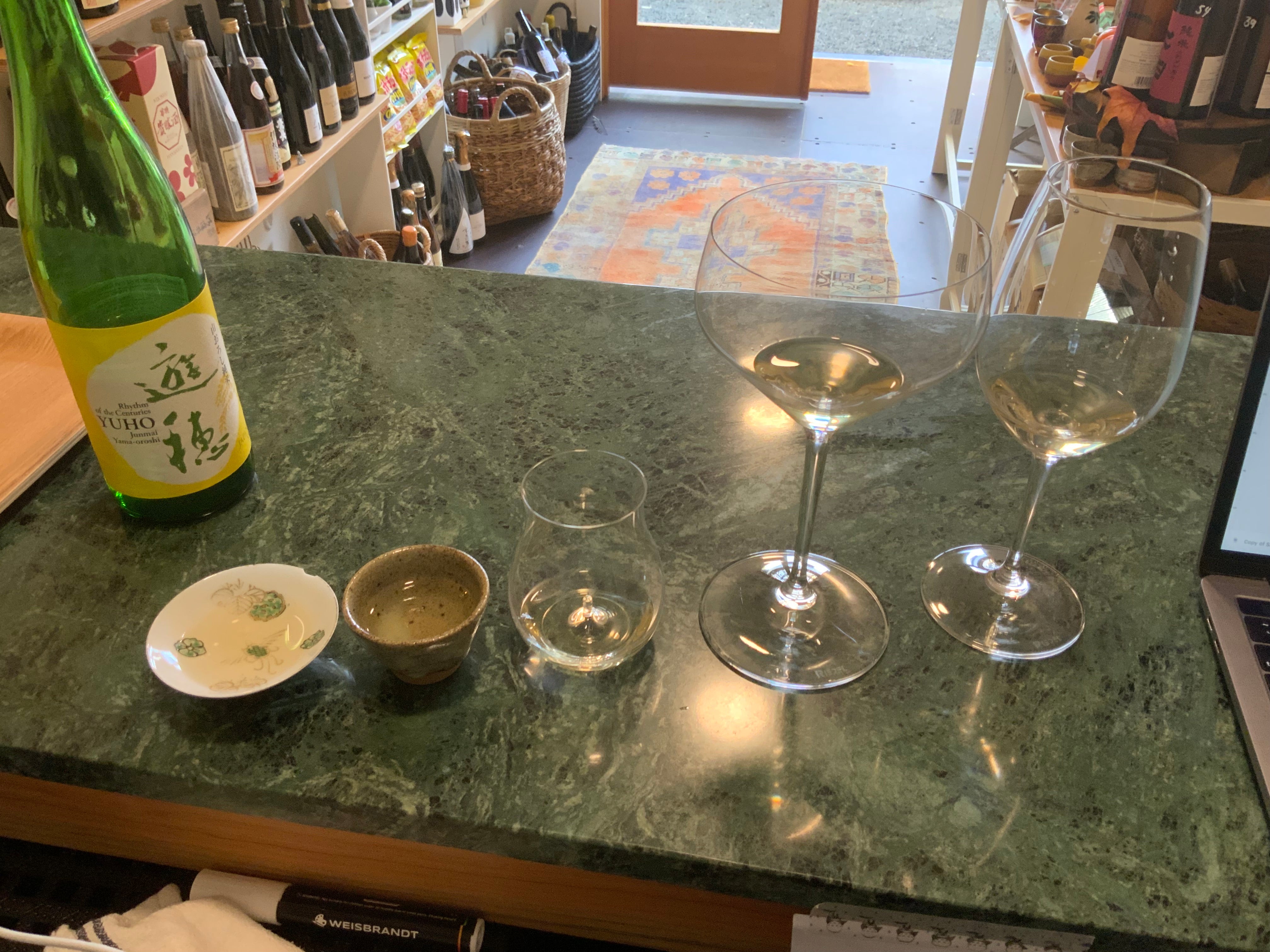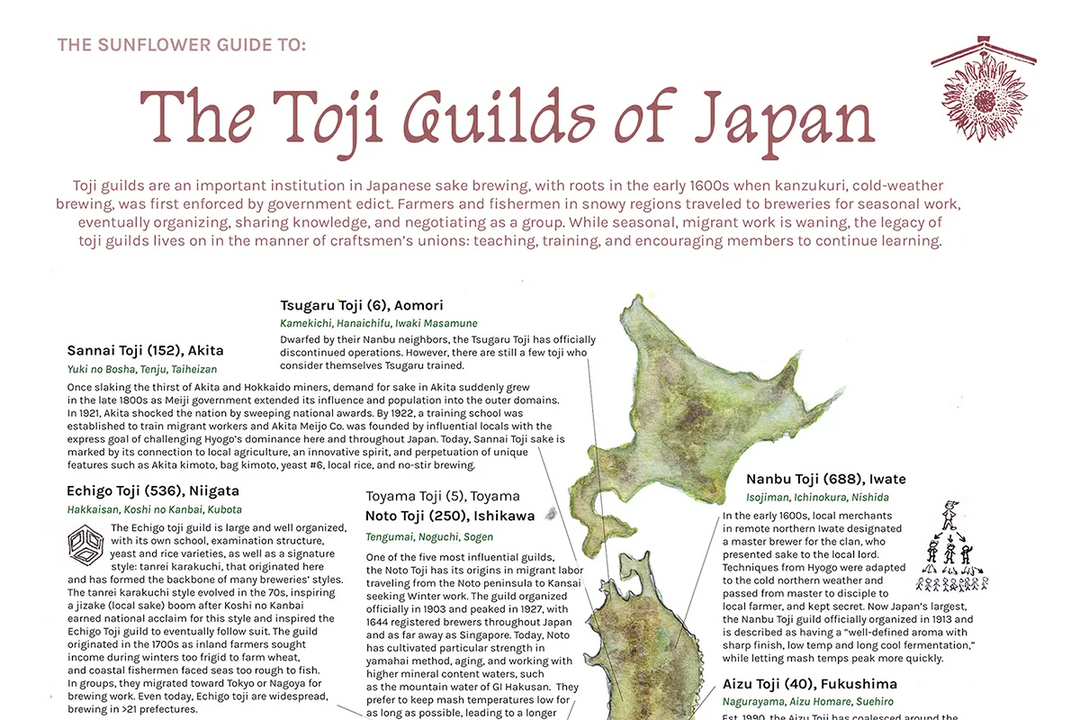Sake Serveware: Extreme Junmai, Wine Glass, Ochoko...How Does it Compare?


“Riedel isn't kidding when they call it the Extreme Junmai,” I thought to myself as I pulled a glass out of the box. Like a champagne coupe on steroids, a Chevy’s margarita glass pulled inward to create a bowl, or a shrimp cocktail glass, I was immediately compelled to take measurements of this thing-- maybe to understand it better. 4” diameter across the bowl, 8” tall, 4.5” stem, roughly 4.25” wide at its widest point. On the truck to Oregon, 20% of the glasses broke. I guess I can see why it’s discontinued. This thing is tremendously impractical-- especially for junmai, the cheapest category of sake.
But I’ve experienced the transformation of fine and appropriate glassware firsthand, in fact as far back as my early 20’s, when I noticed that wine always tasted so much better in restaurants and tasting rooms. At home, mugs and mason jars were our glassware of choice, and even when we upgraded to $2 Ikea stemware it still didn’t taste as good. Why?
It turns out there is a science to glassware: perhaps some of it is ambiance, some is the impression of luxury, but these shapes, weight, balance, aren’t crafted by accident. Different glass thicknesses impact the flavor of the liquid, we perceive different shapes as more or less balanced or elegant, and the size and shape of the bowl determines where the liquid lands on the tongue and how aromas disperse. This monstrosity of a glass, the Riedel junmai, was designed through the careful efforts of hundreds of sake professionals over two years. At the very least, I owed it my consideration.

Which brings me to the present day: a vintage porcelain hirahai (the shallow one), a modern ceramic guinomi (the deeper one), an Usuhari daiginjo glass (the funny one), a Riedel Extreme Junmai (the broad one), and a Riedel Riesling/Zinfandel/Daiginjo glass, will face off in a 3-sake test. I’m excited to say that I’m writing this article as I taste and compare these glasses for the first time. I’m going to begin with the conclusions: a TL;DR you can actually use, but if you’re interested in the details and method, feel free to read further.
Conclusions
Overall best and most versatile: Usuhari daiginjo ($53)
Overall best (budget): Riedel Zinfandel (or any white wine glass) ($15 +/-)
Overall best for savory/umami junmai: Riedel Junmai ($15)
Overall best for daiginjo/floral/fruity: Usuhari daiginjo ($53)
These are my personal conclusions after an informal tasting session with 3 different styles of sake across five different glasses/vessels. If you only want one glass, the honed, carefully Usuhari glass is optimal from a purely objective, aromatic/flavor standpoint. Otherwise, the Riedel Junmai is your best choice for Junmai and the Usuhari is your best choice for Daiginjo. This suggests that the traditional hirahai and guinomi are not technically optimal for any sake.
However, I want to offer a caveat: at home and at Sunflower, most of the time I use traditional serveware anyway. The right ochoko and tokkuri with the right sake, meal, mood and ambiance enhances the aesthetic experience. Colorful glass hirahai resonate with a warm Summer day, while rustic, textured, stoneware feels grounding on a cold Winter day. Over time, you develop an emotional attachment to certain ochoko and using them is like using your favorite coffee mug. Each time you revisit the ochoko you appreciate spending time with it.
So please take these recommendations with a grain of salt. It’s really wonderful to taste sake from the Riedel Junmai and Usuhari glasses, but it’s also wonderful to develop an attachment to your own personal ochoko.
Method
Taste the same sake from each glass and record immediate observations using the WSET Systemic Approach to Tasting, as well as personal remarks. A small amount of each sample will be ingested, because I know from podcast interviews that the Riedel design takes esophageal delivery into consideration. To keep a clear head, any other sips are expelled.
Materials
- Vintage porcelain hirahai, shallow, Kutaniware, ca. early 20th century, enjoyed from an intact portion of the lip. Chosen because of its traditional shallow design.
- Generic, mass-produced modern Japanese guinomi, approximately 1 oz capacity.
- Usuhari Daiginjo glass
- Riedel Extreme Junmai glass
- Riedel Zinfandel/Riesling glass
- Yuho “Rhythm of the Centuries” Junmai Yamahai Koshu, room temperature on a cool day (cellar temp)
- Kanbara “Bride of the Fox” Junmai Ginjo, lightly chilled
- Kameizumi “Eternal Spring” Cel-24 Junmai Daiginjo Nama, chilled (from refrigerator)
Conditions
Chilly day, approximately 10C at 1:20 PM, clear head, average sense of smell.
Initial glassware information and observations
Hirahai

I purchased this piece (on the left) from a local Japanese antiques shop on a discount because of a chip on its lip. To me, that chip adds personality, speaking to its age and even to the people who have used and appreciated it before me. The hirahai is roughly 2” wide and quite shallow, even for this style. The seller estimated its age as early 20th century and region of origin Ishikawa (Kutaniware). It is decorated with flowers. Where it is intact, the lip feels thin and delicate.
As I use this piece, I notice that it forces me into a very delicate, slow, and considered way of drinking. Its capacity is low and its shape is shallow so moving it around is a little precarious. Bringing it to my mouth I must hold it delicately to be sure it doesn’t spill-- there isn’t any room for superfluous motions like swirling or sniffing. As I bring it close to my face I can appreciate the small designs on the cup, the personality of its age, and the color of the sake against the white porcelain background.
Most notably, this cup wouldn’t be appropriate for hot sake. It wouldn’t retain enough heat in a cold environment.
Ochoko
This is a generic ceramic ochoko (on the right) from Mutual Trading Company. Mass produced, maybe $8 retail, made in Japan from a mix of clay formed by a machine then glazed and fired in a huge kiln. Capacity is about 1.5 oz and the lip is smooth, if a little thick. It's a pretty standard cylindrical shape with a rounded bottom. I chose this ochoko because of how generic it is, the most common shape and size, and because it's the kind of ochoko you'd use in most everyday Japanese restaurants.
Riedel Riesling/Zinfandel

After 6 years of development, in 2013, Riedel released their daiginjo glass. Many, many sessions with respected industry professionals, brewers, sake sommeliers, allowed Riedel to narrow down from 300+ shapes to one, the final, the ultimate, daiginjo experience: ...a white wine glass.

Well not exactly, but very close. Close enough that at least in the US, Riedel discontinued the daiginjo glass and is now pointing buyers to the Zinfandel/Riesling glass as the closest equivalent. It’s basically a white wine glass with an elongated tulip and perhaps a slightly wider rim. To the uninitiated, it looks like a standard wine glass. It differs from the daiginjo in that the base of the bowl is a little less graduated, which would have an effect on the rate of liquid flow and the angle of entry.
Usuhari Daiginjo

Usuhari is a serveware brand from Shotoku Glass, established in 1922 as a lightbulb maker and renowned for their niche technique in mouth-blown glass. As the lightbulb industry eventually automated, Shotoku shifted to serveware and is now famous for their durable yet elegant beer and sake glasses. The Usuhari line-- Usuhari means 'thin glass' in Japanese-- was designed to be very thin and lightweight yet deceptively durable. The glass features a consistent 1mm or less thickness and smooth lip. Each glass is still hand-blown and finished individually.
The glass features a central inward spoke in the base which theoretically helps enhance the aroma, agitating the sake more as it is swirled. Where user experience is concerned, out of habit, the glass bowl (as opposed to an ochoko or sakazuki) compels me to smell the contents and swirl-- It encourages me to stop and focus on the aromatics. It’s also hard to use this glass without feeling entertained by the middle finger (spoke)-- it has enough of a unique shape to feel distinct from a wine glass, but still familiar. The glass itself is extremely thin and elegant, and the bowl is small: it fits nicely in my small hand. Some stemless wine glasses feel too big, clunky. This feels small, delicate, elegant and intimate.
Extreme Junmai

Picking this up is wild. It feels almost comical, unreasonable! Like a car that’s way too big, I think to myself: how do I negotiate this enormous thing?
Bringing the glass to my lips, I am immediately aware of the uniqueness of its design. My nose is delivered right to the shallow base of the bowl and I’m surrounded by this 4” diameter of glass. It’s almost surreal, immersive, like looking through a ship’s porthole. I appreciate how different it feels from a standard wine glass...even transportive. I am sake-bubble-girl.
Swirling the sake is satisfying and cautious. With a gentle twirl liquid rises up the side of the shallow bowl, almost to the lip. You can’t swirl much but that’s not a limitation so much as a message about its intended contents. Junmai aren’t really for nosing-- aroma isn’t usually the point. Junmai are much more about palate.
Observations
Sake #1:
Yuho “Rhythm of the Centuries” Junmai Kimoto, a savory, aged junmai with a creamy texture, high umami and complex flavor
Hirahai:
Aromatic intensity muted. In fact, it’s difficult to ponder the aroma because the shallow cup doesn’t allow you to sit with it comfortably, and you can’t swirl the liquid.
The white color of the porcelain shows off the flaxen color of the sake. It’s not so common to have sake with color, so for me personally, being able to see this color can really add to the experience.
Delivery of liquid feels elegant...the front of the tongue is completely bypassed. The hirahai barely needs to be tipped to enter the mouth, so my head remains in place.
Acidity M, sweetness M, umami M, pretty well rounded. The acidity seems lower than usual.
Aesthetics are good, aromatics are poor, and flavor balance is good.
Guinomi
Aromatic intensity L, like the hirahai it’s difficult to enjoy. This ochoko has a narrow rim so there isn’t really room to stick the nose in.
To empty the guinomi, I have to tilt my head a bit. I perceive it as a bit more sharp this time. The guinomi doesn’t provide a lot of aesthetic pleasure, it feels boring, but that’s subjective. The flavor is less notable and maybe because I know this is a generic cup, I don’t spend any time considering it as I sip.
Acidity M+, sweetness L, umami M, structure is a little off balance.
Usuhari
Aromatic intensity M-, but a lot more nuance is coming out compared to the previous two vessels. Toffee, mushrooms deglazed with madeira and cream, sweet soy glaze, roasted sweet potatoes. The nose is much more evocative.
I tilt my head way back to deliver the sake and it lands in the back of the throat. The acidity is definitely emphasized! Acid M+, sweetness M, umami M. It’s more balanced than the guinomi, in a bigger way than the hirahai. I’m thinking that part of this may also be the volume delivered: the hirahai and the guinomi encourage smaller sips due to their smaller size.
Extreme Junmai
Aromatic intensity is muted (L), primarily showing the bigger, sweet elements like caramel and brown sugar. The aromatic impression overall is comparable to the hirahai.
I take my first sip without thinking and honestly, I’m not sure if it’s power of suggestion but the sake tastes noticeably better than it has in the previous 3 vessels. Sweeter, rounder, more flavorful. Because this seems so insane I know I have to go in for a revisit.
Round two, sweet brown sugar on the nose. Sake porthole, loving it. When I sip, the sake is landing about ⅔ the way down my tongue to a spot which is unique in comparison to the other vessels. It passes over the tongue in a smooth, velvety fashion, showing M acidity, M+ umami and M+ acidity, with a soft, creamy texture. The finish is similar to the other vessels, but the start is very different.
Riedel Riesling/Zinfandel
The sake has rested in the bowl for about 30 minutes now. Aromatic intensity M-, slightly lower than the Usuhari but still greater than the other three vessels. The aromatics I’m getting are more pickled rather than sweet. What’s interesting is that due to the elongated tulip, my nose is probably 2.5” further from the liquid versus the junmai, hirahai, or guinomi. Perhaps the sweeter volatiles are heavier, and the more pickled/vegetal volatiles are lighter. Swirling improves the aromatic profile and intensity, but only a little.
On first sip, the acidity is higher than before, the texture is thinner, and the balance is actually still pretty good but the flavor complexity is lower and comes across as a bit shallow. Acid M+, umami M-, sweetness M, balance good but not excellent, texture a little lean.
Sake #2
Kanbara “Bride of the Fox” Junmai Ginjo, a fruity-nutty junmai ginjo with a higher than average umami and an astringent, dry finish.
Hirahai
Aromatic intensity M-, fading into the room rather than being a deliberate experience of nosing the vessel.
The sake enters the mouth in a way where your tongue is held up to the roof and the liquid fills this narrow gap. Acidity is M, sweetness M-, body M-, finish M, umami M-. I am tasting a lot of nuts, dried fruit, sweet-astringent fruit and spice such as persimmons, licorice, ginseng, or monkfruit. The sweetness is sitting on top, even in a slightly irregular way. Shibumi (bitterness) seems a bit pronounced and the sake is tickling my nose-- we’ll see if that’s the glassware or something else.
Guinomi
Acidity M, sweetness M, body M-, finish M-, umami M-, and the delivery to the back of my throat (as I leaned back to finish the cup) actually made me sneeze. The finish really emphasizes the shibumi, but I also get these nice notes of snickerdoodle and cinnamon spiced sweet potato pie.
Usuhari
Aromatic intensity is a little higher than the first two at M, with chestnuts, persimmons and apricot leading.
The delivery is quite nice but also tickling my nose-- this appears to be something about the sake itself. The body is a little higher, a bit more generous and the sweetness seems better integrated, shibumi is still there but more subtle. Notes of coffee, chocolate, dried and fresh persimmon, rye bread, chestnut. Acidity M-, body M, umami M, sweetness M, structural balance very good. With the Usuhari glass, whether due to delivery or amplified aromatics, more nuance is evident.
Riedel Junmai
Aroma is muted, just the slightest sweet smell.
Palate is broad, full, silky, and I actually get very little of the shibumi strangely enough (and again with the nose tickling-- it is the sake!) the delivery really is to the very back of the tongue and while I feel like the complexity is a little lower than other vessels, I’m getting the best version of its texture, body, and structure. Sweet dried persimmon, fresh apricot, pistachio, brazil nut, waves of caramel. Acidity M-, body M, umami M, sweetness M, structural balance excellent.
Zinfandel glass
Nose is a bit more fresh-fruited with fresh late season apricot and nectarine, a bit of honeysuckle, sweet almond or noyeaux butter, a bit tropical, notes of orange wine.
Acidity is a bit higher at M, body a tad lower at M-, umami M- sweetness M-. Shibumi is present but not as pronounced as the hirahai, ochoko, or usuhari. It does taste a bit shallow. I feel like the higher acidity is throwing the balance off a bit.
Sake #3
Kameizumi CEL-24, a highly aromatic, medium-sweet daiginjo sake from Kochi made with cerulenin-resistant yeast.
Hirahai
The aromatics are definitely de-emphasized to M which is unfortunate, because that’s the whole point of the sake-- but I only know that because this isn’t blind.
The liquid is delivered to the soft palate and as a result I only perceive a shallow and cloying sweetness without the flavor and aromatics of fruit, causing it to be out of balance with the other structural elements.
Acidity L, body M-. umami L, sweetness M+, bitterness not perceptible. Balance poor, almost devoid of complexity, just tastes like sugar water.
Ochoko
It’s awkward to nose sake in an ochoko as well. I stick my nose in and I’m sensing a medium intensity aroma of kiwi, strawberry, washed rice, melon soda and green apple. Not as bad as the hirahai but not great either.
Delivery is towards the front of the tongue and under the tongue so I get a bit more acidity, which gives the sake more dimension. I actually don’t know if the act of constant refilling from a tokkuri, or using a chunky guinomi, is appropriate here because it seems disjointed from the crisp elegance of the sake.
Usuhari
The full intensity and complexity of the aroma is on display in the Usuhari glass, which is what I was hoping for after the previous two vessels. A powerful mix of tropical fruit (kiwi, mango puree), sweet fruit (fruit cocktail, tinned pineapple), green apple, ripe strawberry, confected cherry, spun sugar, and sweet, chewy mochi.
The liquid flows over the tongue and I’m made aware of its texture, which is very silky and viscous. By tilting my head back completely, the liquid flows with more force and activates the perception of acidity, giving it a juicy dimension.
I feel like the Usuhari is doing what it should: making the experience interactive, playing up the texture and acidity, and focusing the aroma.
Riedel Junmai
Like the hirahai, almost no aroma here! Which is fascinating because this sake is usually so aromatically intense.
I perceive bitterness where I haven’t with any of the other glasses, which is very strange. It tastes hollow, lightly bitter, and sweet. The fruit and floral aromatics have no dimension, they’re floating without an anchor. The finish is bitter and persistent. This glass really shows the worst side of this sake.
Riedel Zinfandel
Aroma is nice-- sweet, sweet fruits. A bit less complex than the usuhari and a bit less intimate because of the stem. Aromatic intensity is M+ versus P with the usuhari.
Mineral, refreshing, M- acidity, fruit with full dimension. I feel like the umami is more evident here than in the Usuhari, it feels chewier. This glass also draws the sake down the center of the tongue and builds up its structure and body. The finish is clean and sweet, not bitter.
Very pleasant!
Summary
For Junmai Kimoto Koshu (Yuho Rhythm of the Centuries), In terms of drinking pleasure under the conditions of this review, I’d personally rank the glassware as follows:
- Riedel Extreme Junmai: All of the right structural notes are emphasized, leading to a beautifully balanced experience on the palate. However, the aromatic complexity is diminished.
- Usuhari Daiginjo: the unique shape adds a lot of personality and the palate balance is still good. This is the preferred glass for aromatic emphasis.
- Sakazuki: the experience is aesthetically pleasing, and the balance is overall good.
- Riedel Zinfandel: brings out negative qualities on the nose, but the palate is still well balanced, albeit at a different set of frequencies: higher acidity and lower umami.
- Guinomi: slightly sharp and slightly off-balance, but not bad.
For Junmai Ginjo (Kanbara Bride of the Fox):
- Usuhari Daiginjo: aside from its aesthetic value, the Usuhari glass offers the best balance of aromatic delivery and palate structure.
- Riedel Junmai: while the aromatic character is diminished in the junmai glass, the palate is in a fantastic spot, and my personal opinion is that-- since this is a sake well suited to food-- I’d sacrifice some aroma in favor of palate.
- Riedel Zinfandel: very similar balance to the usuhari but with higher acidity, lower umami, and as a consequence an overall shallow impression in the mid-palate. Still a pleasurable drinking experience and an overall good choice.
- Hirahai: roughly tied to the Riedel Zinfandel. Some of the structural balance is off: the sweetness isn’t well integrated, the shibumi is emphasized, and the aroma is diminished, but the complexity and overall balance are still good.
- Guinomi: the act of tipping the head back to drink really seems to deliver the sake to a suboptimal spot. The shibumi (astringency) and dryness make the balance of this sake pretty precarious, and the guinomi just pushes everything in the wrong direction.
For a modern/highly aromatic Junmai Daiginjo (Kameizumi Eternal Spring):
- Usuhari Daiginjo: enhances the aromatic intensity and complexity and subtly increases the acidity on the palate, lending structure and juiciness to the fruit.
- Riedel Zinfandel: delivers a similar aromatic experience to the Usuhari, just a tad milder. On the palate the sake is a bit denser, more umami, and less acidity/juiciness.
- Ochoko: not bad-- aromas are still notable and enjoyable even if they are overall milder and less complex. Palate balance is good, erring toward acidity and juiciness. User experience feels clunky and inelegant, a poor compliment to a daiginjo.
- Hirahai: aromatic complexity is completely lost, the sake tastes sweet and simple, but at least the palate isn’t obviously bitter.
- Riedel Junmai: behaves like the hirahai-- diminishes the aroma causing it to taste like simple sugar water-- but also emphasizes the bitterness. The finish is a long, drawn out, bitter taste.




